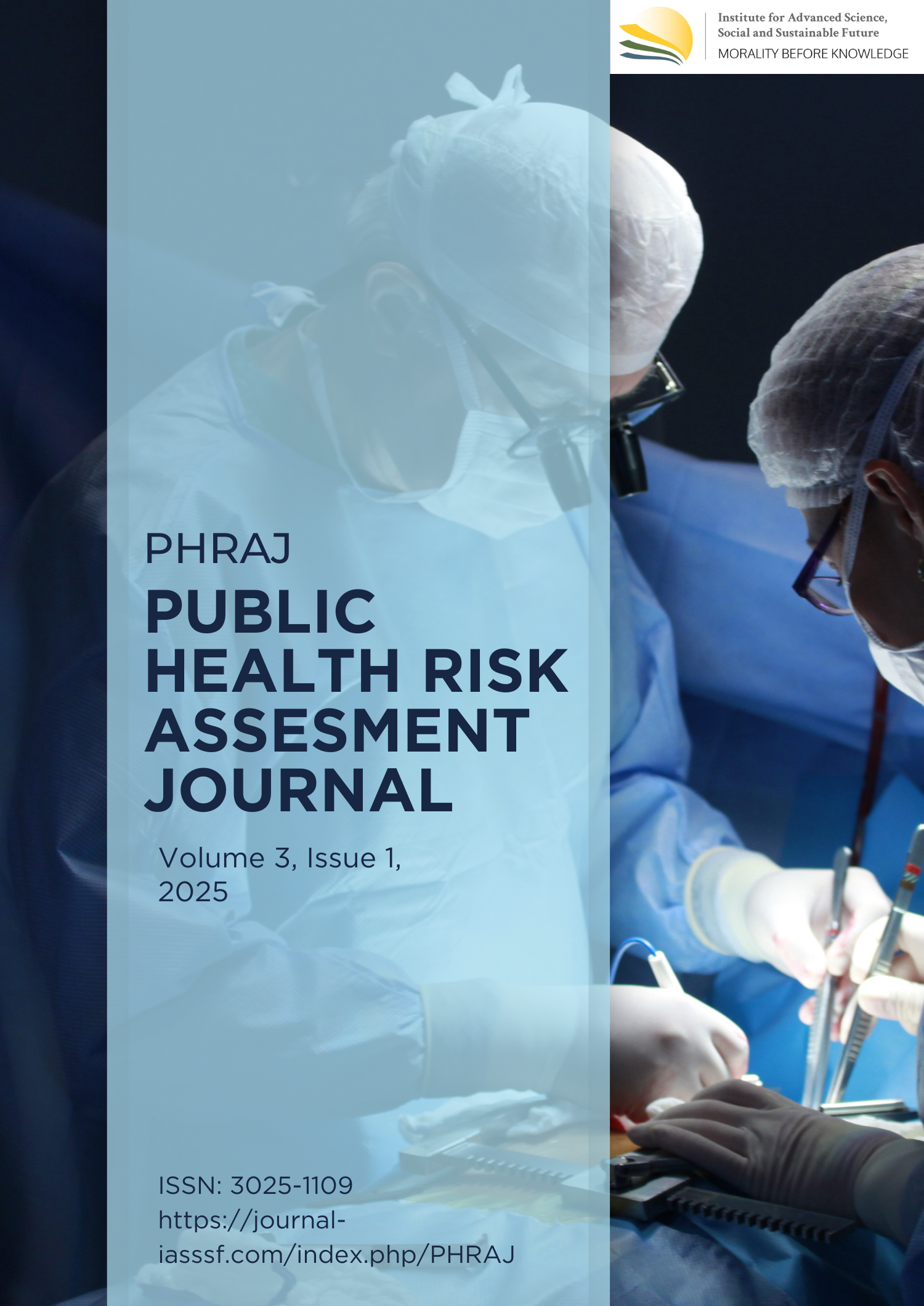Risk factor analysis and preventive health behavior in the control of blood glucose among patients with type II diabetes mellitus: A community-based cross-sectional study
DOI:
https://doi.org/10.61511/phraj.v3i1.2025.1651Keywords:
BMI, blood glucose level, care, DM patients, patient complianceAbstract
Background: Diabetes Mellitus (DM) Disease is rapidly increasing in Indonesia. This disease is defined as either our random blood glucose level >200 mg/dL or fasting blood glucose level >126 mg/dL. Maintaining a controllable blood glucose level (either less than 200 mg/dL for random blood glucose level or less than 126 mg/dL for fasting blood glucose level) in Type II DM patients is obviously playing an important role to avoid any complications such as stroke disease, heart disease and kidney failure. The purpose of this research is to analyze the risk factors contributing to uncontrolled blood glucose in Type II DM patients who come to visit Alak Public Health Centre, city of Kupang. Methods: This research is a quantitative analytic study with cross sectional method, with a total sample of 68 respondents. The statistical analysis carried out by Computer Program is univariate, bivariate and multivariate analysis. Findings: The result of this research shows significant factors contributing to uncontrolled blood glucose level are Body Mass Index (BMI) p value=0.003, patients compliance (p value=0.003), Knowledge of DM (p value=0.011), Regular Physical Activity (p value=0.000), Food Order (p value=0.024), Smoking (p value=0.524) and family support (p value=0.077). The dominant factor which has more significant effect on uncontrolled blood glucose level in Type II DM patients is regular physical activity (p value=0.001). Conclusion: Uncontrolled blood glucose in Type II DM patients is strongly influenced by multiple behavioral and lifestyle factors, with regular physical activity being the most dominant. Strengthening patient education, compliance, and health promotion at the primary care level is essential to improve glycemic control and prevent complications. Novelty/Originality of this article: In order to maintain controlled blood glucose level in Type II DM patients it is suggested that all health workers in public health centre pay more promotive measure to risk factors affecting the bllood glucose in Type II DM patients with effective medias and methods.
References
Adnan, M., Mulyati, T., & Isworo, J. T. (2013). Hubungan indeks massa tubuh (IMT) dengan kadar gula darah penderita diabetes mellitus (DM) tipe 2 rawat jalan di RS Tugurejo Semarang. Jurnal Gizi, 2(1). https://jurnal.unimus.ac.id/index.php/jgizi/article/view/752
East Nusa Tenggara Provincial Health Service. (2018). East Nusa Tenggara Province Health Profile 2018. Central Statistics Agency of West Nusa Tenggara Province.
Ginting, N. M. C. B., & Mufidah, P. K. (2021). Kajian pustaka: Kurangnya kualitas tidur dapat meningkatkan risiko kejadian diabetes melitus. Jurnal Biostatistik, Kependudukan, dan Informatika Kesehatan, 1(3), Article 5. https://doi.org/10.7454/bikfokes.v1i3.1017
Hans, T. (2017). Everything About Diabetes. PT. Gramedia Jakarta.
Knutson, K. L., Ryden, A. M., Mander, B. A., & Van Cauter, E. (2006). Role of Sleep Duration and Severity of Type 2 DM. Archives of Internal Medicine, 166(16), 1768-1774. https://doi.org/10.1001/archinte.166.16.1768
Kupang City Health Service. (2023). Kupang City DM Patient Report 2023. Kupang City Health Service.
Mainous, A. G., III, Tanner, R. J., Anton, S. D., Jo, A., & Luetke, M. C. (2017). Physical Activity and Abnormal Blood Glucose among Healthy Weight Adults. American Journal of Preventive Medicine, 53(1), 42-47. https://doi.org/10.1016/j.amepre.2016.11.027
Mayberry, L. S., & Osborn, C. Y. (2012). Family support, medication adherence, and glycemic control among adults with type 2 diabetes. Diabetes Care, 35(6), 1239–1245. https://doi.org/10.2337/dc11-2103
Ministry of Health. (2021). Health Protocol Handbook Ed.2 Ministry of Health of the Republic of Indonesia.
Musee, C. N., Omondi, D. O., & Odiwuor, W. (2016). Dietary Adherence Pattern in the Context of Type 2 Diabetes Mellitus in Kenya. International Journal of Diabetes Research, 5(2), 26-34. https://doi.org/10.5923/j.diabetes.20160502.02
Nakanishi, N., Nakamura, K., Matsuo, Y., Suzuki, K., & Tatara, K. (2000). Cigarette smoking and risk for impaired fasting glucose and type 2 diabetes in middle-aged Japanese men. Annals of Internal Medicine, 133(3), 183–191. https://doi.org/10.7326/0003-4819-133-3-200008010-00009
Nurasyifa, S. R., Fera, V. V., & Pratiwi, H. (2021.). Hubungan tingkat pengetahuan terhadap manajemen diri pasien Prolanis Diabetes Mellitus Tipe 2. Acta Pharmaceutica Indonesia, 9(2), 78–94. https://doi.org/10.20884/1.api.2021.9.2.4250
Nurayati, L., & Adriani, M. (2017). Hubungan aktifitas fisik dengan kadar gula darah puasa penderita diabetes melitus tipe 2. Amerta Nutrition, 1(2), 80–87. https://doi.org/10.20473/amnt.v1i2.2017.80-87
Nursihhah, M., & Wijaya, D. S. (2021). Hubungan kepatuhan diet terhadap pengendalian kadar gula darah pada pasien diabetes melitus tipe 2. Jurnal Medika Hutama, 2, 1002–1010. https://jurnalmedikahutama.com/index.php/JMH/article/view/203
Onyango, J. T., Namatovu, J. F., Besigye, I. K., Kaddumukasa, M., & Mbalinda, S. N. (2023). Family Support with Glycemic Control among Diabetic Patients in Uganda. The Pan African Medical Journal, 45. https://doi.org/10.11604/pamj.2023.45.72.38256
Perkeni. (2020). Consensus on the Management and Prevention of Type 2 DM in Indonesia. Perkeni.
Prema, G. S., Anitha, R., & Padmini, O. (2016). Relation between body mass index (BMI) and fasting blood sugar (FBS). International Journal of Contemporary Medical Research, 3(1), 91–93. https://journals.indexcopernicus.com/api/file/viewByFileId/428726
Riset Kesehatan Dasar. (2018). Kementerian Kesehatan Republik Indonesia. Riset Kesehatan Dasar.
Rusminingsih, E., & Purnomo, R. T. (2022). Relationship of Patient Characteristics with Medication Adherence Type 2 DM. Indonesian Journal of Global Health Research, 4(3), 603-610. http://jurnal.globalhealthsciencegroup.com/index.php/IJGHR
Sari, M. I., Sari, N., Darlan, D. M., & Prasetya, R. J. (2018). Cigarette smoking and hyperglycaemia in diabetic patients. Open Access Macedonian Journal of Medical Sciences, 6(4), 634–637. https://doi.org/10.3889/oamjms.2018.140
Sendekie, K, A., Netere, A. K., & Kasahun, A. E., & Belachew, E. A. (2022). Medication Adherence and Its Impact on Glycemic Control in Type 2 DM Patients in Northwest Ethiopia. Journal Plusone, 17(9), e0274971. https://doi.org/10.1371/journal.pone.0274971
Sugiyono, D. R. (2009). Quantitative Research Methods Quantitative and RD. Alfabeta Publisher.
Susanti, D., Amita, D., & Ardiansyah, F. (2020). Hubungan dukungan keluarga dengan kadar gula darah pada penyandang diabetes melitus tipe 2 di Puskesmas Beringin Raya Kota Bengkulu. Malahayati Nursing Journal (MNJ), 2(3). https://doi.org/10.33024/mnj.v2i3.2884
Susilawati, W. D., & Hasanah, U. (2023). Influence of Diet and Blood Glucose Levels in Type 2 DM Patients, Mataram City General Hospital, NTB Province. Research of Service Administration, 4(91). http://dx.doi.org/10.58258/rehat.v4i1.5346
Tasali, E., Leproult, R., & Spiegel, K. (2009). Reduced Sleep Duration or Quality; Relationships with Type 2 Diabetes. Progress in Cardiovascular Disease, 51(5), 381-391. https://doi.org/10.1016/j.pcad.2008.10.002
Teh, C. H., Chan, Y. Y., Lim, K. H., Kee, C. C., Lim, K. K., Yeo, P. S., Azahadi, O., Fadhli, Y., Tahir, A., Lee, H. L., & Nazni, W. A. (2015). Association of Physical Activity with Blood Glucose among Malaysian Adults. BMC Public Health, 5, 1-7. https://doi.org/10.1186/s12889-015-2528-1
Velázquez López, L., Muñoz Torres, A. V., Medina Bravo, P. G., & Escobedo de la Peña, J. (2023). Inadequate diabetes knowledge is associated with poor glycemia control in patients with type 2 diabetes. Atención Primaria, 55(5), 102604. https://doi.org/10.1016/j.aprim.2023.102604
Wang, D., Qiang, D., Xu, W., Wang, J., Liu, J., Qin, Y., Zhang, Y., Liu, Q., & Xiang, Q. (2022). Smoking Causes The Disorder of Glucose Metabolism. The Journal of Clinical Hypertension, 24(10), 1276-1284. https://doi.org/10.1111/jch.14557
Wulandari, N., Maifitrianti, M., Hasanah, F., Atika, S., & Dini Putri, R. (2020). Medication adherence assessment among patients with type 2 diabetes mellitus treated with polytherapy in Indonesian community health center: A cross-sectional study. Journal of Pharmacy and Bioallied Sciences, 12(2), S758–S762. https://doi.org/10.4103/jpbs.JPBS_257_19
Yuliawati, A. N., Ratnasari, P. M. D., & Rosalina, P. R. (2022). Knowledge and Quality of Life in Type 2 DM Patients. JMPF, 12(1). https://doi.org/10.22146/jmpf.68631
Downloads
Published
How to Cite
Issue
Section
Citation Check
License
Copyright (c) 2025 Panondang N. Panjaitan, Pius Weraman, Apris A. Adu

This work is licensed under a Creative Commons Attribution 4.0 International License.















